Related Research Articles

The Treaty of Cahuenga, also called the Capitulation of Cahuenga, was an 1847 agreement that ended the Conquest of California, resulting in a ceasefire between Californios and Americans. The treaty was signed at the Campo de Cahuenga on 13 January 1847, ending the fighting of the Mexican-American War within Alta California. The treaty was drafted in both English and Spanish by José Antonio Carrillo and signed by John C. Frémont, representing the American forces, and Andrés Pico, representing the Mexican forces.

The Compromise of 1850 was a package of five separate bills passed by the United States Congress in September 1850 that temporarily defused tensions between slave and free states in the years leading up to the American Civil War. Designed by Whig senator Henry Clay and Democratic senator Stephen A. Douglas, with the support of President Millard Fillmore, the compromise centered around how to handle slavery in recently acquired territories from the Mexican–American War (1846-48).

The United Mexican States is a federal republic composed of 32 federal entities: 31 states and Mexico City, an autonomous entity. According to the Constitution of 1917, the states of the federation are free and sovereign in all matters concerning their internal affairs. Each state has its own congress and constitution.
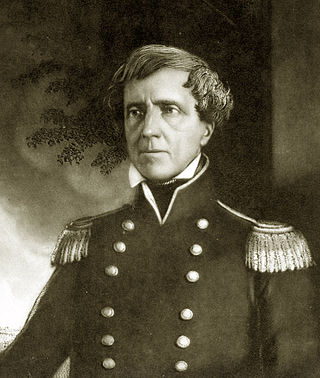
Stephen Watts Kearny was one of the foremost antebellum frontier officers of the United States Army. He is remembered for his significant contributions in the Mexican–American War, especially the conquest of California. The Kearny code, proclaimed on September 22, 1846, in Santa Fe, established the law and government of the newly acquired territory of New Mexico and was named after him. His nephew was Major General Philip Kearny of American Civil War fame.

Major-General Sterling Price was a United States General and senior officer of the Confederate States Army who fought in both the Western and Trans-Mississippi theaters of the American Civil War. He rose to prominence during the Mexican–American War and served as governor of Missouri from 1853 to 1857. He is remembered today for his service in Arkansas (1862–1865) and for his defeat at the Battle of Westport on October 23, 1864.
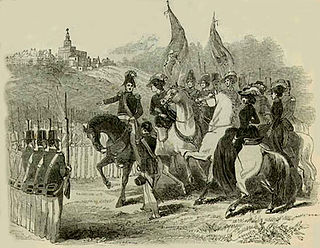
The Nauvoo Legion was a state-authorized militia of the city of Nauvoo, Illinois, United States. With growing antagonism from surrounding settlements it came to have as its main function the defense of Nauvoo, and surrounding Latter Day Saint areas of settlement.
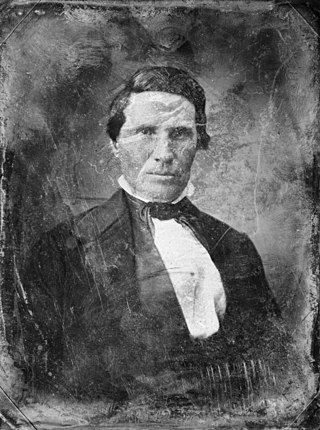
Alexander William Doniphan was a 19th-century American attorney, soldier and politician from Missouri who is best known today as the man who prevented the summary execution of Joseph Smith, founder of the Church of Jesus Christ of Latter Day Saints, at the close of the 1838 Mormon War in that state. He also achieved renown as a leader of American troops during the Mexican–American War, as the author of a legal code that still forms the basis of New Mexico's Bill of Rights, and as a successful defense attorney in the Missouri towns of Liberty, Richmond and Independence.
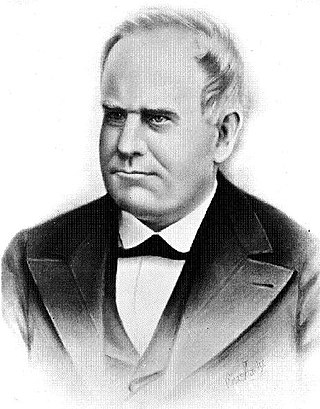
William Willard Preble Hall was an American lawyer and politician. He served as the 17th Governor of Missouri from 1864 to 1865 during the last years of the American Civil War.
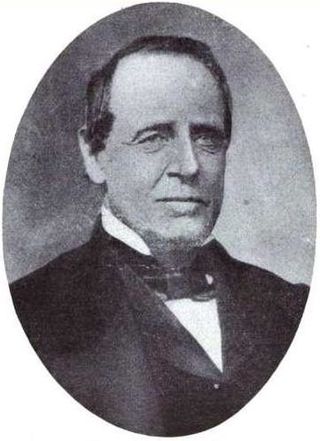
Henry Connelly was Governor of the New Mexico Territory during the American Civil War. He was appointed by President Lincoln and served from September 4, 1861 until July 6, 1866. During his term, the territory broke into two, and then three parts due to the Civil War and administrative problems.

The present-day state of Nebraska was still a territory of the United States during the American Civil War. It did not achieve statehood until March 1867, two years after the war ended. Nevertheless, the Nebraska Territory contributed significantly to the Union war effort.

The Mexican–American War, also known in the United States as the Mexican War and in Mexico as the Intervención estadounidense en México, was an armed conflict between the United States and Mexico from 1846 to 1848. It followed the 1845 American annexation of Texas, which Mexico still considered its territory. Mexico refused to recognize the Treaties of Velasco, because they were signed by President Antonio López de Santa Anna while he was captured by the Texas Army during the 1836 Texas Revolution. The Republic of Texas was de facto an independent country, but most of its Anglo-American citizens wanted to be annexed by the United States.

Under the provisions of the Kearny Code as promulgated in 1846, the first legislature of New Mexico commenced its session on December 6, 1847. The Council consisted of seven members, with Antonio Sandoval, of Bernalillo County, as president, and the House of twenty-one members, with W. Z. Angney as speaker.
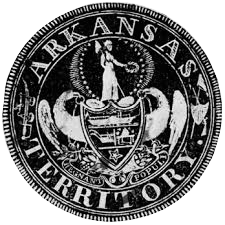
The Militia of the Territory of Arkansas, commonly known as the Arkansas Militia, was the forerunner of today's Arkansas National Guard. The current Arkansas Army National Guard traces its roots to the creation of the territorial militia of the District of Louisiana in 1804. As the District of Louisiana evolved into the Territory of Missouri and the first counties were organized, regiments of the Missouri territorial militia were formed in present-day Arkansas. Territorial governors struggled to form a reliable militia system in the sparsely populated territory. When the Arkansas Territory was formed from the Missouri Territory, the militia was reorganized, gradually evolving from a single brigade composed of nine regiments to an entire division composed of six brigades, each containing four to six regiments. The local militia organization, with its regular musters and hierarchy added structure to the otherwise loosely organized territorial society. The Territorial Militia was utilized to quell problems with the Indian Nations and was held in readiness to deal with trouble along the border with Mexico due to an ambiguous international border and during the prelude to the Texas War of Independence.
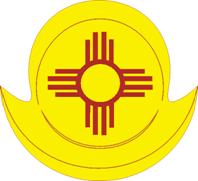
The New Mexico Army National Guard is a component of the United States Army and the New Mexico National Guard. The NM ARNG traces its history back to units formed when New Mexico was still a territory.

Brigadier General Diego Archuleta, was a member of the Mexican Congress. He joined the Mexican Army to fight against the United States in the Mexican–American War. Later, he was appointed an Indian Agent by President Abraham Lincoln, and joined the Union Army during the American Civil War. Archuleta became the first Hispanic to reach the military rank of Brigadier General.
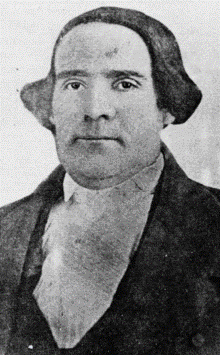
Donaciano Vigil (1802-1877) was an American politician who served as the second governor of the New Mexico Territory. Born a subject of the Spanish Crown in Santa Fe to Nuevomexicanos parents, he served in the militias during Mexican rule in New Mexico. After the United States annexed New Mexico following the Mexican–American War, Vigil helped smooth the transition to American governance.

William Claude Jones was an American politician, poet, fabulist, and "pursuer of nubile females". Among his accomplishments, he was a member of the Missouri and Arizona Territorial legislatures, United States Attorney for New Mexico Territory, and a member of the Hawaiian privy council.

The interim government of California existed from soon after the outbreak of the Mexican–American War in mid-1846 until U.S. statehood in September, 1850. There were three distinct phases:
Guam is an island in the Marianas archipelago of the Northern Pacific located between Japan and New Guinea on a north–south axis and Hawaii and the Philippines on an east–west axis. Inhabitants were Spanish nationals from 1521 until the Spanish-American War of 1898, from which point they derived their nationality from United States law. Nationality is the legal means in which inhabitants acquire formal membership in a nation without regard to its governance type. In addition to being United States nationals, people born in Guam are both citizens of the United States and citizens of Guam. Citizenship is the relationship between the government and the governed, the rights and obligations that each owes the other, once one has become a member of a nation. Though the Constitution of the United States recognizes both national and state citizenship as a means of accessing rights, Guam's history as a territory has created both confusion over the status of its nationals and citizenship and controversy because of distinctions between jurisdictions of the United States.
The Marianas archipelago of the Northern Pacific contains fourteen islands located between Japan and New Guinea on a north–south axis and Hawaii and the Philippines on an east–west axis. Inhabitants were Spanish nationals from the 16th century until the Spanish-American War of 1898. As Guam became a territory of the United States the Northern Marianas were sold to Germany in 1899. The Northern Mariana Islands were a German protectorate until 1919, when they became part of the South Seas Mandate, administrated by Japan. At the close of World War II, the Marianas became part of the Trust Territory of the Pacific Islands. In 1975, the Commonwealth of the Northern Mariana Islands became a self-governing territory. In 1986, the Marianas came under the sovereignty of the United States when the trusteeship ended and US nationality and citizenship was conferred on the inhabitants of the territory.
References
- The Avalon Project at Yale Law School: Bill of Rights for the Territory of New Mexico; September 22, 1846
- Territorial Laws and Treaties: Kearny Code of Laws New Mexico Statutes Annotated, The Michie Company, Charlottesville, Virginia, OCLC 22609116
- Farish, Thomas Edwin (1915) History of Arizona Vol. 1, p. 133, OCLC 1703859